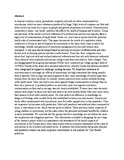| dc.contributor.author | Kiama, T N | |
| dc.contributor.author | Sirma, A J | |
| dc.contributor.author | Senerwa, D M | |
| dc.contributor.author | Ochungo, P | |
| dc.contributor.author | Waithanji, E | |
| dc.contributor.author | Lindahl, j | |
| dc.contributor.author | Kang'ethe, E K | |
| dc.contributor.author | Grace, D | |
| dc.date.accessioned | 2015-03-31T09:22:41Z | |
| dc.date.available | 2015-03-31T09:22:41Z | |
| dc.date.issued | 2013 | |
| dc.identifier.citation | Kiama, T. N., Sirma, A. J., Senerwa, D. M., Ochungo, P., Waithanji, E., Lindahl, J., ... & Grace, D. (2013). How qualitative studies and gender analysis can add value to the assessment of dietary exposure to aflatoxins in Kenya. | en_US |
| dc.identifier.uri | http://hdl.handle.net/11295/81834 | |
| dc.description.abstract | In tropical countries, maize, groundnuts, sorghum and milk are often contaminated by mycotoxins, which are toxic substances produced by fungi. High levels of exposure are fatal and lower levels can cause liver cancer in people and growth depression in livestock. Mycotoxicosis constitutes a classic ‘one health’ problem that affects the health of humans and livestock. Kenya has had some of the world’s severest outbreaks of mycotoxicosis and surveys typically show a high level of contamination of staple foods. However, much less is known about the potential health risks of contaminated milk. This paper documents the results of a qualitative study conducted in Kenya on risk of exposure to mycotoxins in the dairy value chain in which the knowledge, attitude and practices of mycotoxin management by men and women were compared. A risk map was developed based on previous occurrence of aflatoxicosis and other factors such as farming systems and dairy cattle density. From this, three categories were identified: high risk with and without historical outbreaks and low risk with historical outbreaks. Three districts were randomly selected per category and from each district, three villages. Two sex-disaggregated focus group discussions (FGDs) were conducted per village giving a total of 54 FGDs. Results of the study were analysed inductively, whereby trends and patterns identified were categorized to support or challenge existing theories. We found low awareness of mycotoxicosis or carcinogenic effects of mycotoxins, but high awareness that eating mouldy food is harmful. Men in high risk areas appeared to have more knowledge of mould types than women from the same locations. In contrast, women practiced more caution towards feeding cattle spoilt maize. More preventive measures against fungal contamination in storage than on farm were practiced. A gendered pattern on preventive practices against mycotoxin contamination on farm and in storage was not clearly established. Women were main decision-makers with respect to dairy cow diets and what to do with mouldy foods. Men were more likely than women to feed cattle mouldy maize. No clear pattern on difference in knowledge on dangers of feeding cattle mouldy feeds was established between men and women. Commercial feeds, often contaminated with mycotoxins, were fed cattle regularly but in low quantities. They are expensive but increase milk production. Most milk produced was sold and when consumed at home, it was mainly in tea, which was not given to infants. These practices reduce exposure of young children to mycotoxins, but they also reduce the potential nutritional benefits for children in dairy households. We conclude that the groups that have knowledge are not always the same that implement risk mitigation practices. This information is helpful in designing the next stage of the research project which is a quantitative risk assessment of the health impacts of mycotoxins in the Kenyan dairy value chain linked with an economic assessment of the costs of mycotoxins to the livestock and health sector. In addition this study shows that gender analysis and qualitative studies can make important contributions to risk analysis for ‘One Health’ problems. | en_US |
| dc.language.iso | en | en_US |
| dc.publisher | University of Nairobi | en_US |
| dc.title | How qualitative studies and gender analysis can add value to the assessment of dietary exposure to aflatoxins in Kenya | en_US |
| dc.type | Other | en_US |
| dc.type.material | en | en_US |

